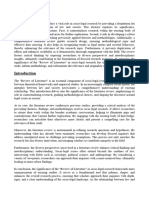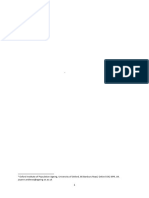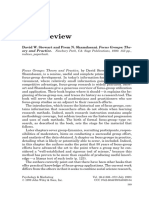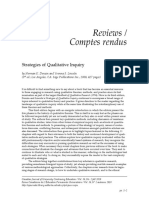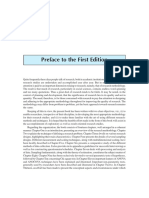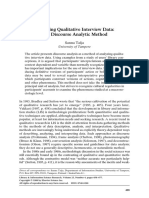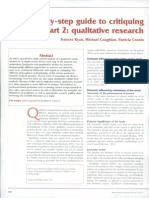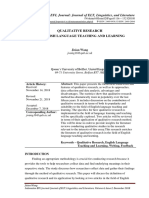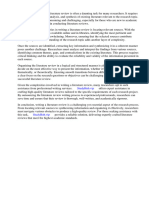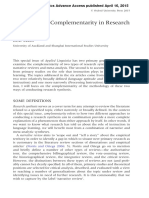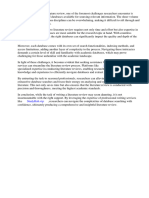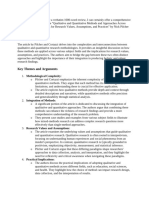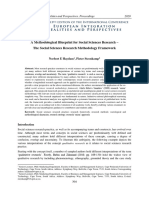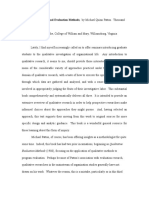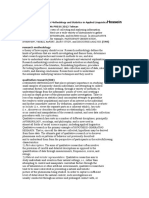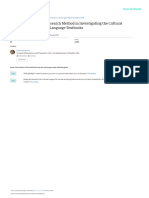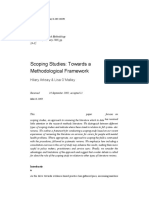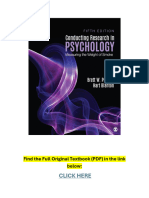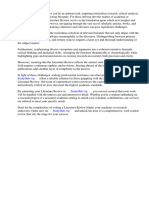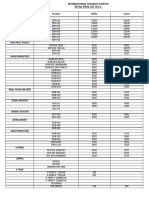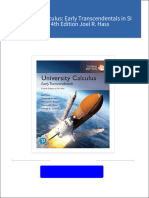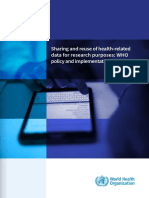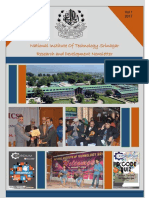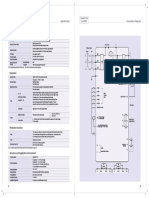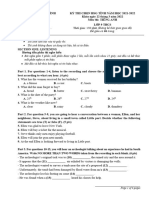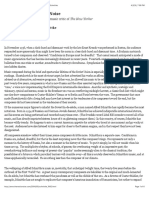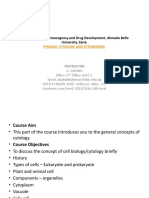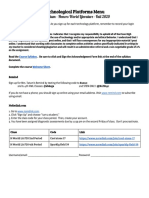Gabriela Saldanha and Sharon O'Brien - Research Methodologies in Translation Studies
Gabriela Saldanha and Sharon O'Brien - Research Methodologies in Translation Studies
Uploaded by
yosafat baronaCopyright:
Available Formats
Gabriela Saldanha and Sharon O'Brien - Research Methodologies in Translation Studies
Gabriela Saldanha and Sharon O'Brien - Research Methodologies in Translation Studies
Uploaded by
yosafat baronaOriginal Title
Copyright
Available Formats
Share this document
Did you find this document useful?
Is this content inappropriate?
Copyright:
Available Formats
Gabriela Saldanha and Sharon O'Brien - Research Methodologies in Translation Studies
Gabriela Saldanha and Sharon O'Brien - Research Methodologies in Translation Studies
Uploaded by
yosafat baronaCopyright:
Available Formats
See discussions, stats, and author profiles for this publication at:
https://www.researchgate.net/publication/303600726
Gabriela Saldanha and Sharon
O’Brien: Research Methodologies
in Translation Studies
Article in Across Languages and Cultures · June 2016
DOI: 10.1556/084.2016.17.1.8
CITATIONS READS
0 467
1 author:
Federico Zanettin
Università degli Studi di Perugia
25 PUBLICATIONS 221 CITATIONS
SEE PROFILE
All content following this page was uploaded by Federico Zanettin on 30 June 2016.
The user has requested enhancement of the downloaded file.
Across Languages and Cultures 17 (1), pp. 143–147 (2016)
DOI: 10.1556/084.2016.17.1.8
Book Review
Gabriela Saldanha and Sharon O’Brien
Research Methodologies in Translation Studies
Manchester: St Jerome, 2013, xiii + 277 pp. ISBN 978-1-909485-00-6 (pbk)
The volume by Saldanha and O’Brien is a timely contribution to the field of
translation studies. The cover of the book aptly offers its central metaphor, that
of a compass as a help to navigation, as opposed, for instance to that of a map
(Williams and Chesterman 2002). The authors set out to systematize the body of
knowledge about the methodologies and methods used in translation studies. At
the same time, however, by endeavouring to provide a comprehensive review of
the types of research carried out around translation practices, the book outlines a
landscape of the territory of translation studies, and functions as a repository of
helpful terms, concepts and practical information.
In the first introductory chapter the authors carefully draw the boundaries
of their work, declaring their focus on empirical research, explaining the or-
ganization of the volume, and acknowledging possible limitations within its
scope. After comparing their approach to that of previous publications on re-
search methodology, the authors distinguish between four different ways of do-
ing research, which are then developed in the four central chapters of the vol-
ume. The distinction has to do with the nature of the data, whether they concern
the product or the process of translation, the participants or the wider social and
cultural context in which translated texts are embedded.
The second chapter offers a presentation of essential aspects of research
design, discussing the importance of research questions and hypotheses, litera-
ture review and different approaches to the data. Parameters for research quality
are also outlined. The authors start by discussing some of the main concepts re-
lated to research methodology in the human sciences, and provide definitions of
general theoretical terms such as ontology and epistemology, induction, deduc-
tion and abduction, as well as of operational concepts such as validity and sam-
pling. Terms and concepts are clearly explained by applying them to examples
of actual translation studies research and are then recalled and used throughout
the following chapters. Considerable importance is attributed to a discussion of
ethical issues, ranging from informed consent (including the usability of data
collected through the Internet) to plagiarism.
1585-1923/$ 20.00 © 2016 Akadémiai Kiadó, Budapest
144 BOOK REVIEW
Chapter 3 deals with translation product research, that is, research on the
linguistic content of translated texts. It focuses on two empirical approaches
which have informed many studies, that is, Critical Discourse Analysis (CDA)
and Corpus Linguistics (CL), which privilege a qualitative and a quantitative
approach to the data, respectively. After introducing CDA and CL and their use
in translation studies, the chapter looks at the advantages and limitations of the
two approaches, both of which usually rely on systemic functional grammar as
their “linguistic toolkit”. Basic corpus linguistics techniques are explained, and
their application to translation studies in a critical discourse analysis perspective
is discussed. The last part of this chapter provides a broad coverage of multiple
models of quality assessment (QA), as an attempt to bring some order and co-
herence in the multiplicity of models available. The discussion of QA is rather
comprehensive, especially as regards methods used for the evaluation of ma-
chine translation output, and readers are directed to other sources for further
discussion.
Chapter 4 is dedicated to translation process research, and focuses on the
most common methods used to investigate the mental processes, i.e. verbal re-
ports, which include introspective methods such as Think-Aloud-Protocols
(TAPs, still the main methodology in translation-process studies), keystroke
logging and eye tracking. Other methods, such as screen and audio recordings,
ethnographic studies, personality profiling and various types of psychological
measurements are also included in the discussion. The authors provide a re-
search overview, which includes studies on cognitive processes, with reference
to working rhythm and concurring activities, processing effort, creativity and
competence, the latter usually with a pedagogical focus. The main issues in
process research are examined under the headings of design, data elicitation,
analysis and reporting, stressing that all measurements are ultimately indirect.
The authors point to some inconsistencies in how different groups of partici-
pants (e.g. professionals, experts, semi-professionals, novices) have been de-
fined in the literature and explain relevant criteria in the design of translation
process research, including issues of participants selection, task description and
elicitation techniques. They also discuss problems related to the definition of a
unit of analysis in process research, either in textual/linguistic or temporal
terms, and ways of assessing the significance of such units using statistical
techniques. This chapter underlines that research on the process of translation
should be combined with both product- and context-oriented research, using
both qualitative and quantitative methods and triangulating the results, and cor-
relating findings with quality assessment.
Chapter 5 presents the third major grouping of research methods, those in-
volving research regarding the human agents in the translation activity. The au-
thors consider various factors which may be relevant in designing participant-
Across Languages and Cultures 17 (1) (2016)
BOOK REVIEW 145
oriented research, and which involve the collection of data using questionnaires,
interviews and focus groups. After considering the various types and structures
of questionnaires and interviews and weighing their respective pros and cons,
the authors discuss a number of issues related to good practice. These include
the language used, the way participants are selected and the way data are elic-
ited, how the analysis is conducted, and ethical issues. This chapter also deals at
some length with qualitative and quantitative methods of analysis. While quali-
tative analysis is explained mostly with reference to interviews and quantitative
analysis with reference to questionnaires, the methodological aspects described
are also relevant and applicable to, for instance, the qualitative analysis of au-
dio/video recorded dialogue from interpreting sessions and to statistical testing
in corpus-based approaches, respectively. This chapter concludes with a section
of mixed quantitative and qualitative approaches for data validation and triangu-
lation.
Chapter 6 deals with research carried out within conceptual frameworks
and through methodological procedures derived from cultural studies, sociol-
ogy, and ethnography. This type of studies is not identified by a specific meth-
odology, but rather by the engaged, political nature of the investigation, which
explores the cultural, social and political factors influencing the specific (trans-
lational) phenomenon under analysis. The most common type of research
method used in this area is the case study, defined as a unique unit of investiga-
tion and a real life phenomenon in relation with its wider context. After sketch-
ing out a typology of case studies, including extreme, deviant, crucial, critical,
revelatory and typical cases, the authors argue that, given the variety of this type
of research, no single methodology is most appropriate. However, some general
principles are outlined, such as the need to follow disciplined practice, to avoid
bias by selecting multiple sources of information and to triangulate results. The
authors highlight that case studies are optimally indicated for exploring ques-
tions, generating hypotheses and testing the viability of theoretical frameworks.
Research based on case studies, like all qualitative research, is an iterative proc-
ess: it does not keep to a linear pattern from data collection to analysis but
rather data collection and analysis are done simultaneously, following an induc-
tive approach which may lead to a reconsideration of the research design. Case
studies are based on evidence that is rarely fully coherent, and therefore it is
important to be flexible and be ready to apply theoretical models to the case at
hand rather than vice versa. While they can be very different and their results
are not usually replicable and generalizable, when case studies are based on a
clear methodology and on sound documentation, and offer a transparent discus-
sion of results, they provide transferable evidence. Thus, “it is important to
choose them carefully for their relevance, for the significance of the issues they
will raise, the hypotheses that they can help to formulate, their capacity to im-
Across Languages and Cultures 17 (1) (2016)
146 BOOK REVIEW
prove on previous theories, and the insights they can provide into the complex
mechanisms through which social, political, cultural and ideological forces
shape translations and are shaped by them” (p. 233). The authors discuss vari-
ous research aids which may be used to systematically organize and analyze the
data, such as a database, a research diary, analytical memos and visual data dis-
plays. They also suggest a number of software applications for qualitative
analysis which can be used for managing and organizing the data, highlighting
both the advantages and the possible draw-backs of computer-aided analysis.
The last chapter illustrates the final step of research, which involves its
communication and dissemination, in particular though the publication of re-
search reports. The chapter is tightly structured: after a general introduction to
research report formats and standards, its main recurrent components (introduc-
tion, literature review and conclusions) are outlined. This is followed by a dis-
cussion of the type of methods used to report the research design, the collection
of the data, and the analytical approach adopted. The last three sections are each
devoted to an illustration of and suggestions about developing best practices for
reporting about qualitative, quantitative and linguistic data.
As would any attempt to organize and systematize a complex and interdis-
ciplinary field such as that of translation studies methodologies, the disciplinary
territory navigated by the volume is bound to have some gaps, overlaps, and un-
even levels of detail. The most apparent gaps, readily acknowledged by the au-
thors, are the areas of translation history and interpreting studies. Thus, re-
searchers working on, for instance, Renaissance translation, dialogue or confer-
ence interpreting, may be advised (and are directed by the authors) to refer to
additional and more specific methodological resources. Overlaps happen when,
for instance, in considering the various sources of data used in case studies
(Chapter 6), which include written texts (academic literature, translations,
paratexts, archives, etc.) as well as verbal reports, direct observation, physical
artefacts and quantitative data, the reader is directed to more in-depth discussion
in other chapters. However, the rationale behind the structure of the book is al-
ways clearly explained, in accordance with the methodological principles ex-
pounded. For example, while the section on quality assessment could possibly
have been placed in almost any chapter, its inclusion in the chapter on product
research is justified by the fact that most studies on QA are indeed done in this
research area. The central chapters (four and five), which focus on methodolo-
gies with clear procedural steps (e.g. keystroke logging, eye tracking, question-
naires and interviews), are illustrated in more detail than methodological ap-
proaches affording a wider scope, such as those of CDS and CL, and case stud-
ies. The level of detail reached in, for instance, the description of eye tracking
experiments is unparalleled elsewhere. When methodological, procedural and
technical features and aspects are less elaborated upon, the reader is clearly re-
Across Languages and Cultures 17 (1) (2016)
BOOK REVIEW 147
ferred to studies which discuss those aspect more in depth, with a view to elabo-
rating on their respective advantages and limitations.
The choice of what to include, the consideration accorded to the material
and its systematization are, of course, always arbitrary, reflecting to some extent
the authors’ own research interests and expertise. As a whole, however, the vol-
ume is well planned and structured, with useful section and subsection break-
ups and cross references, making it easy for the reader to use for reference.
Since the methodologies described often come from other disciplines, including
sociology, linguistics and psychology, the sources cited range from ethnometh-
odological studies to computational linguistics, from cognitive psychology to
functional-systemic grammar, and include publications in languages such as
Spanish, French and German. The authors offer a wealth of good advice and de-
tailed instructions (or a mix of the two), as well as an emphasis on ethical con-
siderations and implications. To conclude, the volume is certainly an asset in the
bookshelf of the translation studies student, researcher, and scholar alike.
Federico Zanettin
Perugia, Italy
E-mail: federico.zanettin@unipg.it
References
Williams, J. & Chesterman, A. 2002. The Map – A Beginner’s Guide to Doing Research in Trans-
lation Studiens. Manchester, UK: St. Jerome.
Across Languages and Cultures 17 (1) (2016)
View publication stats
You might also like
- KLB Chem FORM 2Document170 pagesKLB Chem FORM 2Job Makori Ombui100% (4)
- Analysing Texts - TonkissDocument14 pagesAnalysing Texts - Tonkissaeskii0% (1)
- End of Chapter QuestionsDocument4 pagesEnd of Chapter QuestionsFritz NatividadNo ratings yet
- King - Template AnalysisDocument24 pagesKing - Template AnalysisAnita Johnson75% (4)
- John W. Creswell, Research DesDocument4 pagesJohn W. Creswell, Research Desmatamerah100% (2)
- Case Study Research in Applied LinguisticsDocument4 pagesCase Study Research in Applied LinguisticsZunc ZunaidahNo ratings yet
- 2.1. Methodological Directions in Translation StudiesDocument12 pages2.1. Methodological Directions in Translation StudiesYousef Ramzi TahaNo ratings yet
- Metodología First PartDocument7 pagesMetodología First PartJohn Jeiver Obando LeonNo ratings yet
- Scholarly Writing and Publishing PrincipleDocument13 pagesScholarly Writing and Publishing PrincipleEdessa MasinasNo ratings yet
- Qualitative Research in Applied LinguisticsDocument12 pagesQualitative Research in Applied LinguisticssadeghiehNo ratings yet
- RM AllDocument9 pagesRM AllPratham AgrawalNo ratings yet
- Book Review Research Methods in The Social Sciences, by Chava Frankfort-Nachmias, David Nachimas and Jack de Waard (8th EdiDocument7 pagesBook Review Research Methods in The Social Sciences, by Chava Frankfort-Nachmias, David Nachimas and Jack de Waard (8th EdiFATIMA BOUREZINo ratings yet
- Riazi 2014Document40 pagesRiazi 2014Weronika KrzebietkeNo ratings yet
- A Hibrid Approach To Thematic Analisis in Qualitative ReserchDocument28 pagesA Hibrid Approach To Thematic Analisis in Qualitative ReserchJackie Popper MintNo ratings yet
- Focus Groups Theory and PracticeDocument4 pagesFocus Groups Theory and PracticeJosé Félix Salazar CrucesNo ratings yet
- Reviews / Comptes Rendus: Strategies of Qualitative InquiryDocument2 pagesReviews / Comptes Rendus: Strategies of Qualitative InquiryAlex MaugoNo ratings yet
- 2015 - Gentles, Charles, Ploeg, McKibbon - Sampling in Qualitative ResearchDocument16 pages2015 - Gentles, Charles, Ploeg, McKibbon - Sampling in Qualitative ResearchTomas Hubner NeumannNo ratings yet
- PubSub10268 ClarkeDocument3 pagesPubSub10268 ClarkeJohana GavilanesNo ratings yet
- Research Design: Qualitative, Quantitative, and Mixed Methods ApproachesDocument3 pagesResearch Design: Qualitative, Quantitative, and Mixed Methods ApproachesFurkanSayinNo ratings yet
- Pages From Research Methdology-8Document2 pagesPages From Research Methdology-8clip claps5No ratings yet
- Book Review: Research Methods in LinguisticsDocument8 pagesBook Review: Research Methods in LinguisticsindrakuNo ratings yet
- Article Project Key Methods Used in Qualitative Document AnalysisDocument9 pagesArticle Project Key Methods Used in Qualitative Document AnalysisNOEL KHANTNo ratings yet
- Analyzing Qualitative DataDocument19 pagesAnalyzing Qualitative DatayonpurbaNo ratings yet
- 2007 Step by Step Guide To Critiquing Research Part 2 Qualitative ResearchDocument8 pages2007 Step by Step Guide To Critiquing Research Part 2 Qualitative ResearchthemanofmanNo ratings yet
- Content Analysis of Deixis and Speech Acts Features of Self Improvement Book JournalDocument15 pagesContent Analysis of Deixis and Speech Acts Features of Self Improvement Book JournalVirky Ummah100% (1)
- Blending Qualitative and Quantitative ReDocument15 pagesBlending Qualitative and Quantitative ReAli Shimal KzarNo ratings yet
- Advantages of Literature Review in ResearchDocument5 pagesAdvantages of Literature Review in Researchcmppcmwgf100% (1)
- 3348-Article Text-10029-1-10-20190526Document17 pages3348-Article Text-10029-1-10-20190526Dung trươngNo ratings yet
- Applying systemic functional linguistics in translation studiesDocument29 pagesApplying systemic functional linguistics in translation studiespp.peng1097No ratings yet
- Research Methodology Based On Literature ReviewDocument7 pagesResearch Methodology Based On Literature Reviewea4hasywNo ratings yet
- Ellis 2015Document6 pagesEllis 2015ABDERRAHIM FATMINo ratings yet
- A Hybrid Approach To Thematic Analysis in Qualitative Research: Using A Practical ExampleDocument22 pagesA Hybrid Approach To Thematic Analysis in Qualitative Research: Using A Practical ExampleCarlo Jesús Orellano QuijanoNo ratings yet
- Databases That Can Be Used To Conduct Literature ReviewDocument4 pagesDatabases That Can Be Used To Conduct Literature Reviewea6xrjc4No ratings yet
- Bikner-Ahsbahs Et Al. - Investigación Cualitativa en Educación Matemática PDFDocument587 pagesBikner-Ahsbahs Et Al. - Investigación Cualitativa en Educación Matemática PDFlina caamañoNo ratings yet
- Views On The Combination of Quantitative and QualiDocument14 pagesViews On The Combination of Quantitative and Qualimaddog67No ratings yet
- Qualitative Research QualitativeDocument13 pagesQualitative Research QualitativeJakaria AhmedNo ratings yet
- Pilcher and Cortazzi's articleDocument3 pagesPilcher and Cortazzi's articleminedataNo ratings yet
- Term PaperDocument139 pagesTerm PaperCyra REMOQUILLONo ratings yet
- A Methodical Blueprint For Social Scinces Research - The Social Sciences Research Methodology FrameworkDocument22 pagesA Methodical Blueprint For Social Scinces Research - The Social Sciences Research Methodology Frameworkaltynsarin.prom.2004No ratings yet
- Review of Qualitative Research and Evaluation MethodsDocument6 pagesReview of Qualitative Research and Evaluation MethodsShariif Nouri100% (2)
- Does Methodology Come Before Literature ReviewDocument5 pagesDoes Methodology Come Before Literature Reviewafmzwflmdnxfeb100% (1)
- Review of Related Literature and Studies Research PaperDocument8 pagesReview of Related Literature and Studies Research Paperea3mfh42No ratings yet
- Creswell: Chapter 3 Designing Qualitative StudyDocument9 pagesCreswell: Chapter 3 Designing Qualitative StudyAcel Folledo-Sanguir100% (2)
- Summary of Social Research Methods by Lawrence NeumanDocument3 pagesSummary of Social Research Methods by Lawrence Neumanimamakh900No ratings yet
- Statisticsin Corpus LinguisticsDocument7 pagesStatisticsin Corpus LinguisticsDaniela Jazmin Silva PiñaNo ratings yet
- Literature Review Vs MethodologyDocument5 pagesLiterature Review Vs Methodologyc5rggj4c100% (1)
- Hossein Tavakoli: Research Method 2012 TehranDocument9 pagesHossein Tavakoli: Research Method 2012 TehranFaith Ful100% (1)
- Qualitative Data Analysis For Health Research - A Step-by-Step ExaDocument20 pagesQualitative Data Analysis For Health Research - A Step-by-Step Exasanjana.mehtaNo ratings yet
- Content Analysis Jolace 2014Document35 pagesContent Analysis Jolace 2014Fatima AthmaniNo ratings yet
- Examining The Potential of Combining The Methods of Grounded Theory and Narrative Inquiry - A Comparative AnalysisDocument22 pagesExamining The Potential of Combining The Methods of Grounded Theory and Narrative Inquiry - A Comparative AnalysisNguyễn Thu TrangNo ratings yet
- Primary Research PrepubversionDocument5 pagesPrimary Research PrepubversionSannan Asad ArfeenNo ratings yet
- Drisko 2005-Writing Up Qualitative ResearchDocument5 pagesDrisko 2005-Writing Up Qualitative ResearchTuti AgustinNo ratings yet
- Arksey and OMalley - 2005 - Scoping StudiesDocument17 pagesArksey and OMalley - 2005 - Scoping StudiesCBNo ratings yet
- Conducting Research in Psychology Measuring The Weight of Smoke 5th Edition PDFDocument11 pagesConducting Research in Psychology Measuring The Weight of Smoke 5th Edition PDFbelilic190No ratings yet
- Research Notes 1Document169 pagesResearch Notes 1Kenneth KimondoNo ratings yet
- International Journal of Social Research MethodologyDocument17 pagesInternational Journal of Social Research MethodologyresfreakNo ratings yet
- Example of A Graduate Level Literature ReviewDocument7 pagesExample of A Graduate Level Literature Reviewafmzwrhwrwohfn100% (1)
- Creswell 2003 Literature ReviewDocument8 pagesCreswell 2003 Literature Reviewc5swkkcn100% (2)
- Comparative Methods in Sociology: Essays on Trends and ApplicationsFrom EverandComparative Methods in Sociology: Essays on Trends and ApplicationsNo ratings yet
- Antiarrhythmic DrugsDocument59 pagesAntiarrhythmic DrugsCharles YiuNo ratings yet
- Cathedral PinesDocument1 pageCathedral PinesjrpizzoniaNo ratings yet
- Icl Price ListDocument1 pageIcl Price ListRK DanishNo ratings yet
- đề 2Document5 pagesđề 2linhphamngoc2909No ratings yet
- Instant ebooks textbook University Calculus: Early Transcendentals in SI Units 4th Edition Joel R. Hass download all chaptersDocument40 pagesInstant ebooks textbook University Calculus: Early Transcendentals in SI Units 4th Edition Joel R. Hass download all chapterstaberaanor100% (1)
- Drama Scholarship Performance Standard Dec12Document2 pagesDrama Scholarship Performance Standard Dec12Scot HallNo ratings yet
- DTS Profile 1Document13 pagesDTS Profile 1KJ WorldwideNo ratings yet
- Sharing and Reuse of Health-Related Data For Research Purposes: WHO Policy and Implementation GuidanceDocument28 pagesSharing and Reuse of Health-Related Data For Research Purposes: WHO Policy and Implementation GuidanceU VenkateshNo ratings yet
- Maintenance Engineering-6026-Module-4Document43 pagesMaintenance Engineering-6026-Module-4Prithviraj PNo ratings yet
- 270 - Exam Form Fill-Up Notification - Summer 2024Document1 page270 - Exam Form Fill-Up Notification - Summer 2024dhairyanshuahirNo ratings yet
- Newsletter - 2017 (32 PG)Document32 pagesNewsletter - 2017 (32 PG)sweety kumariNo ratings yet
- Control: Specification Connection DiagramDocument1 pageControl: Specification Connection DiagramSudipto MajumderNo ratings yet
- Teknik Menjawab Soalan Bahasa Inggeris Kertas 2 1119Document27 pagesTeknik Menjawab Soalan Bahasa Inggeris Kertas 2 1119nasha yacobNo ratings yet
- De HSG Anh 9 2021-2022Document6 pagesDe HSG Anh 9 2021-2022hangngaqb2010No ratings yet
- Topics III Fluid MachineryDocument26 pagesTopics III Fluid Machinerywarren carozcaNo ratings yet
- Years Bestbusinessthinking: Celebrating OF THEDocument108 pagesYears Bestbusinessthinking: Celebrating OF THEmmsingiNo ratings yet
- Osu WPL 46Document124 pagesOsu WPL 46DANNA ANDRADENo ratings yet
- Consolidated Statement of Financial Position: (With Comparative Fugures For CY 2016)Document6 pagesConsolidated Statement of Financial Position: (With Comparative Fugures For CY 2016)Alicia NhsNo ratings yet
- Connoisseur of Chaos: SchnittkeDocument6 pagesConnoisseur of Chaos: SchnittkeRobert MorrisNo ratings yet
- Barrie Zoning By-Law 2009-141 120413 PDFDocument159 pagesBarrie Zoning By-Law 2009-141 120413 PDFSalsa_Picante_BabyNo ratings yet
- Edkris Semera Final Thesis 2023Document101 pagesEdkris Semera Final Thesis 2023Duke GlobalNo ratings yet
- Impact of Dividend Policy On Firm Performance: An Empirical Evidence From Pakistan Stock ExchangeDocument7 pagesImpact of Dividend Policy On Firm Performance: An Empirical Evidence From Pakistan Stock ExchangeZeeni KhanNo ratings yet
- Performance Measurement - Don't Let Metrics Undermine Your BusinessDocument3 pagesPerformance Measurement - Don't Let Metrics Undermine Your Businessankita kashyapNo ratings yet
- Assessment 5 - Technical Report WritingDocument2 pagesAssessment 5 - Technical Report Writingpranavdeshpande2499No ratings yet
- PHCG 201 CytologyDocument113 pagesPHCG 201 CytologyIbn HaarūnNo ratings yet
- Salesforce Meta Data APIDocument435 pagesSalesforce Meta Data APIAnkush DurejaNo ratings yet
- HWL f20 Tech Menu 1Document3 pagesHWL f20 Tech Menu 1api-292181772No ratings yet
- Acute Stroke and Transient Ischemic AttackDocument22 pagesAcute Stroke and Transient Ischemic Attackmits98No ratings yet
- CYD Agreement Addendum Non Compete Agreement TemplateDocument4 pagesCYD Agreement Addendum Non Compete Agreement Templatekool waNo ratings yet










